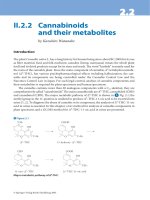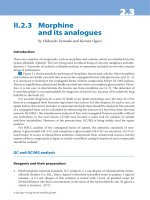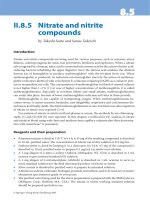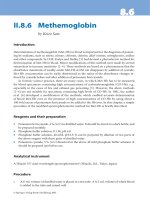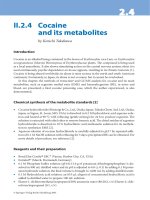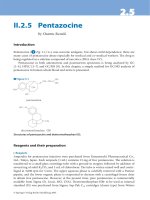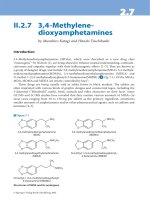MCQs and EMQs in Surgery - A Bailey _ Love[Shared by Ussama Maqbool]
Bạn đang xem bản rút gọn của tài liệu. Xem và tải ngay bản đầy đủ của tài liệu tại đây (5.32 MB, 586 trang )
990674_MCQ_As_Surgery_CV_3_ARNOLD 22/04/2010 15:21 Page 1
B&L
COMPANION GUIDE
With over 1000 questions, MCQs and EMQs in Surgery is the ideal self-assessment
companion guide to Bailey & Love’s Short Practice in Surgery. The book assists readers in their
preparation for examinations and enables them to test their knowledge of the principles and
practice of surgery as outlined within Bailey & Love.
Sub-divided into 13 subject-specific sections, both MCQs and EMQs provide a comprehensive
coverage of the surgical curriculum as well as the core learning points as set out in Bailey & Love.
Each section emphasises the importance of self-assessment within effective clinical
examination and soundly based surgical principles, whilst taking into account the latest
developments in surgical practice.
MCQs and EMQs in Surgery is an excellent companion to Bailey & Love and provides a
valuable revision tool for those studying for MRCS.
One of the world's pre-eminent medical textbooks beloved by
generations of surgeons.
To find out more visit www.baileyandlove.com
I S B N 978-0-340-99067-4
9
780340 990674
Bailey & Love
COMPANION GUIDE
MCQs & EMQs
in Surgery
Datta Bulstrode Praveen
About the authors
Pradip K Datta MBE, MS, FRCS (Ed, Eng, Irel, Glas) is Honorary Consultant Surgeon, Caithness
General Hospital, Wick, Member of Council and College Tutor, Royal College of Surgeons of
Edinburgh.
Christopher J K Bulstrode MCh, FRCS (Orth) is Professor and Honorary Consultant Trauma
and Orthopaedic Surgeon, University of Oxford, Member of Council, Royal College of
Surgeons of Edinburgh.
B V Praveen MS, FRCS (Ed, Eng, Glas, Irel, Gen) is Consultant Surgeon and Associate Director of
Medical Education, Southend University Hospital, Honorary Senior Lecturer, Queen Mary,
University of London.
MCQs & EMQs in Surgery
Bailey & Love
Pradip K Datta, Christopher J K Bulstrode, B V Praveen
Bailey & Love
COMPANION GUIDE
MCQs and
EMQs in
Surgery
Pradip K Datta MBE, MS, FRCS (Ed, Eng, Irel, Glasg), Honorary
Consultant Surgeon, Caithness General Hospital, Wick, Member of
Council and College Tutor, Royal College of Surgeons of Edinburgh
Christopher J K Bulstrode MCh, FRCS (Orth), Professor and
Honorary Consultant Trauma and Orthopaedic Surgeon, University of
Oxford, Member of Council, Royal College of Surgeons of Edinburgh
B V Praveen MS, FRCS (Ed, Eng, Glasg, Irel, Gen), Consultant
Surgeon and Associate Director of Medical Education, Southend
University Hospital, Honorary Senior Lecturer, Queen Mary, University
of London
Prelimsxvi.indd i
4/14/2010 2:31:03 PM
CRC Press
Taylor & Francis Group
6000 Broken Sound Parkway NW, Suite 300
Boca Raton, FL 33487-2742
© 2010 by Taylor & Francis Group, LLC
CRC Press is an imprint of Taylor & Francis Group, an Informa business
No claim to original U.S. Government works
Version Date: 20121026
International Standard Book Number-13: 978-1-4441-2829-1 (eBook - PDF)
This book contains information obtained from authentic and highly regarded sources. Reasonable
efforts have been made to publish reliable data and information, but the author and publisher cannot
assume responsibility for the validity of all materials or the consequences of their use. The authors and
publishers have attempted to trace the copyright holders of all material reproduced in this publication
and apologize to copyright holders if permission to publish in this form has not been obtained. If any
copyright material has not been acknowledged please write and let us know so we may rectify in any
future reprint.
Except as permitted under U.S. Copyright Law, no part of this book may be reprinted, reproduced,
transmitted, or utilized in any form by any electronic, mechanical, or other means, now known or
hereafter invented, including photocopying, microfilming, and recording, or in any information storage or retrieval system, without written permission from the publishers.
For permission to photocopy or use material electronically from this work, please access www.copyright.com ( or contact the Copyright Clearance Center, Inc. (CCC), 222
Rosewood Drive, Danvers, MA 01923, 978-750-8400. CCC is a not-for-profit organization that provides licenses and registration for a variety of users. For organizations that have been granted a photocopy license by the CCC, a separate system of payment has been arranged.
Trademark Notice: Product or corporate names may be trademarks or registered trademarks, and are
used only for identification and explanation without intent to infringe.
Visit the Taylor & Francis Web site at
and the CRC Press Web site at
Contents
Foreword
ix
Contributors
x
Preface
xi
Acknowledgements
xii
List of Abbreviations Used
xiii
Introduction
xvi
PART 1: PRINCIPLES
1
1 The metabolic response to injury
3
■ Pradip Datta
2 Shock and blood transfusion
8
■ Bandipalyam Praveen
3 Wounds, tissue repair and scars
16
■ Bandipalyam Praveen
4 Surgical infection
22
■ Bandipalyam Praveen
5 Tropical surgery
31
■ Pawanindra Lal, Sanjay De Bakshi
6 Paediatric surgery
75
■ Pradip Datta
7 Oncology
84
■ Bandipalyam Praveen
8 Surgical audit and research
90
■ Bandipalyam Praveen
9 Surgical ethics
94
■ Pradip Datta
10 Diagnostic imaging
96
■ Pradip Datta
PART 2: INVESTIGATION AND DIAGNOSIS
101
11 Gastrointestinal endoscopy
103
■ Bandipalyam Praveen
iii
Prelimsxvi.indd iii
4/14/2010 2:31:04 PM
CONTENTS
12 Tissue diagnosis
107
■ Pradip Datta
PART 3: PERIOPERATIVE CARE
111
13 Preoperative preparation
113
■ Bandipalyam Praveen
14 Anaesthesia and pain relief
118
■ Nigel Webster
15 Care in the operating room
122
■ Pradip Datta
16 The high-risk surgical patient
124
■ Bandipalyam Praveen
17 Nutrition and fluid therapy
127
■ Nandini Rao
18 Basic surgical skills and anastomosis
135
■ Pradip Datta
19 Laparoscopic and robotic surgery
137
■ Bandipalyam Praveen
20 Postoperative care
144
■ Pradip Datta
PART 4: TRAUMA
151
21 Introduction to trauma
153
■ Pradip Datta
22 Trauma epidemiology
156
■ Christopher Bulstrode
23 Head injury
160
■ Lynn Myles
24 Neck and spine
166
■ Christopher Bulstrode
25 Trauma to the face and mouth
171
■ Charles Perkins
26 Trauma to the chest and abdomen
176
■ Pradip Datta
iv
Prelimsxvi.indd iv
4/14/2010 2:31:04 PM
185
■ Christopher Bulstrode
28 Burns
195
CONTENTS
27 Extremity trauma
■ John McGregor
29 Plastic and reconstructive surgery
205
■ John McGregor
30 Disaster surgery
212
■ Christopher Bulstrode
PART 5: ELECTIVE ORTHOPAEDICS
217
31 Elective orthopaedics: musculoskeletal examination
219
■ Christopher Bulstrode
32 Sports medicine
224
■ Christopher Bulstrode
33 The spine
233
■ Christopher Bulstrode
34 The upper limb
238
■ Christopher Bulstrode
35 The hip and knee
246
■ Christopher Bulstrode
36 The foot and ankle
252
■ Christopher Bulstrode
37 Infection and tumours
257
■ Christopher Bulstrode
38 Paediatric orthopaedics
264
■ Christopher Bulstrode
PART 6: SKIN AND SUBCUTANEOUS TISSUE
271
39 Skin and subcutaneous tissue
273
■ Pradip Datta
PART 7: HEAD AND NECK
281
40 Elective neurosurgery
283
■ Lynn Myles
v
Prelimsxvi.indd v
4/14/2010 2:31:04 PM
CONTENTS
41 The eye and orbit
292
■ Brian Fleck
42 Cleft lip and palate: developmental
abnormalities of face, mouth and jaws
302
■ John McGregor
43 The nose and sinuses
309
■ Iain J Nixon
44 The ear
319
■ Iain J Nixon
45 Pharynx, larynx and neck
330
■ Iain J Nixon
46 Oropharyngeal cancer
341
■ Iain J Nixon
47 Disorders of the salivary glands
351
■ Iain J Nixon
PART 8: BREAST AND ENDOCRINE
361
48 Thyroid and the parathyroid gland
363
■ Nandini Rao
49 Adrenal glands and other endocrine disorders
375
■ Nandini Rao
50 The breast
385
■ Pradip Datta
PART 9: CARDIOTHORACIC
389
51 Cardiac surgery
391
■ Dumbor Ngaage
52 The thorax
397
■ Dumbor Ngaage
PART 10: VASCULAR
403
53 Arterial disorders
405
■ Peter McCollum
54 Venous disorders
411
■ Peter McCollum
vi
Prelimsxvi.indd vi
4/14/2010 2:31:04 PM
416
■ Peter McCollum
PART 11: ABDOMINAL
421
56 History and examination of the abdomen
423
CONTENTS
55 Lymphatic disorders
■ Pradip Datta
57 Hernia, umbilicus and abdominal wall
425
■ Bandipalyam Praveen
58 The peritoneum, omentum, mesentery
and retroperitoneal space
432
■ Pradip Datta
59 The oesophagus
437
■ Pradip Datta
60 Stomach and duodenum
441
■ Bandipalyam Praveen
61 The liver
451
■ Pradip Datta
62 The spleen
458
■ Pradip Datta
63 The gall bladder and bile ducts
461
■ Bandipalyam Praveen
64 The pancreas
468
■ Pradip Datta
65 The small and large intestines
474
■ Pradip Datta
66 Intestinal obstruction
488
■ Bandipalyam Praveen
67 The vermiform appendix
495
■ Pradip Datta
68 The rectum
499
■ Pradip Datta
69 The anus and anal canal
504
■ Bandipalyam Praveen
vii
Prelimsxvi.indd vii
4/14/2010 2:31:04 PM
CONTENTS
PART 12: GENITOURINARY
513
70 Urinary symptoms and investigations
515
■ Pradip Datta
71 The kidneys and ureters
521
■ Pradip Datta
72 The urinary bladder
533
■ Pradip Datta
73 The prostate and seminal vesicles
541
■ Pradip Datta
74 The urethra and penis
546
■ Pradip Datta
75 The testis and scrotum
549
■ Pradip Datta
76 Gynaecology
554
■ Pradip Datta
PART 13: TRANSPLANTATION
559
77 Transplantation
561
■ Bandipalyam Praveen
Index
569
viii
Prelimsxvi.indd viii
4/14/2010 2:31:04 PM
Foreword
This innovative companion volume will certainly be considered as an
essential complement to Bailey & Love’s Short Practice of Surgery. The
authors and contributors have recognised the fundamental changes
that have occurred in surgical training and assessment where greater
knowledge must be acquired in a shorter period of time, not only to
ensure success in examinations but also to provide the comprehensive
foundations on which to build clinical expertise. The Silver Jubilee
edition of Bailey & Love in 2008 emphasised its enduring importance for
generations of surgeons internationally. MCQs and EMQs in Surgery will
define the indispensable elements for today’s surgical practitioners.
John D Orr, FRCS (Ed)
ix
Prelimsxvi.indd ix
4/14/2010 2:31:04 PM
Contributors
Sanjay De Bakshi MS FRCS (Eng & Ed)
Consultant Surgeon, Calcutta Medical Research Institute (CMRI), Kolkata,
India
Brian W Fleck FRCS (Ed), MD Consultant Ophthalmic Surgeon, Princess
Alexandra Eye Pavilion and Royal Hospital for Sick Children, Edinburgh
Professor Pawanindra Lal MS DNB MNAMS FRCS (Ed & Eng)
Professor of Surgery, Maulana Azad Medical College, New Delhi, India
Professor Peter McCollum MCh, FRCS (Ed), FRCSI
Professor of Vascular Surgery, Hull/York Medical School
John C McGregor BSc (Hons) MBChB (with commendation) FRCS, FRCS
(Edin)
Former Consultant in Plastic, Reconstructive and Cosmetic Surgery,
St John’s Hospital, West Lothian
Lynn Myles BSc (Hons), MB ChB, MD, FRCS (SN)
Consultant Neurosurgeon, Department of Clinical
Neurosciences, Western General Hospital, Edinburgh
Dumbor L Ngaage MB BS FRCS (Ed), FWACS, FRCS (C-Th), FETCS
(Cardiovascular), FETCS (Thoracic), MS
Specialist Registrar in Cardiothoracic Surgery, Castle Hill Hospital, Hull.
Honorary Clinical Tutor, Hull York Medical School, Universities of Hull &
York
Iain J. Nixon MBChB FRCS (Edin.) Specialist Registrar in Otolaryngology
Head and Neck Surgery, West of Scotland Rotation. Clinical Research
Fellow, Memorial Sloan Kettering Cancer Center, New York, USA
Charles S Perkins FDSRCS, FFDRCSI, FRCS
Consultant Oral and Maxillofacial Surgeon, Gloucestershire Royal and
Cheltenham General Hospitals, Gloucestershire
Nandini P Rao, MRCP, Msc
Specialist Registrar in Chemical Pathology/Metabolic Medicine, Royal Free
Hospital, London
Professor N R Webster MB ChB PhD FRCA FRCP FRCS
Institute of Medical Sciences, Foresterhill, Aberdeen
x
Prelimsxvi.indd x
4/14/2010 2:31:04 PM
Preface
First published in 1932, Bailey & Love’s Short Practice of Surgery has
stood the test of time. Perhaps this is an understatement, considering
that all three of us have used the book as medical students! This book
has been the result of good foresight on the part of Hodder Arnold to
keep up with the changing trends in the pattern of surgical examinations,
both at undergraduate and postgraduate levels. The publishers should
be congratulated in bringing out this book – converting the original
Silver Jubilee (25th) edition – all 77 chapters of it – as Multiple Choice
Questions (MCQs) and Extended Matching Questions (EMQs).
The book is aptly titled as a companion to Bailey & Love. We would
therefore hope that the reader, specifically preparing for a written
examination, would use this book as the major reading material, referring
to the original for detailed elucidation of a particular point or operative
detail.
Most of the contributors are different from Bailey & Love’s Short
Practice of Surgery except for chapters 5, 25 the section on orthopaedics
and part of trauma. Thus while retaining the essence of the original
material, this book has been seasoned by different authors, thus giving
it a fresh flavour without losing any of its original ingredients. We are
grateful to all the contributors for their prompt response in spite of the
pressures of work in the National Health Service.
The images and pictures are mostly different to those in the original
book, giving this tome an added attraction. While the MCQs test
knowledge, the EMQs with the illustrations give a good format for a
self-assessment exercise. The chapters are specifically geared towards
helping the reader with preparation for the written papers of the MRCS
and FRCS(Gen) examinations. The undergraduate will also find this book
equally stimulating for the same reasons. In surgical examinations in
the English-speaking world, where essays have been replaced by shortanswer questions (short notes of yesteryear), the reader will find the
EMQs ideal preparation.
Any book must be dynamic, much more so a new venture such as
this. It was said in the preface of the parent book, “Whereas the past
informs the present, it must never enslave the future.” As authors of this
very exciting project we can stay true to the spirit of this statement only
with help from you – our readers. Therefore we look forward to your
suggestions and constructive criticisms for the next edition.
Pradip K Datta
Christopher J K Bulstrode
B V Praveen
November 2009
xi
Prelimsxvi.indd xi
4/14/2010 2:31:04 PM
Acknowledgements
An email from Gavin Jamieson to one of us (PKD) was the inspiration
behind this publication, he being the catalyst who set alight our
enthusiasm to write this book. Thus to him we owe a huge debt of
gratitude for getting this project off the ground. Indeed it is a tribute to all
concerned that this book was published in just over a year since the idea
was born as his brainchild.
All the contributors have done a tremendous job not only in producing
comprehensive chapters but also delivering them on time – and this, in
spite of the pressures of the present-day National Health Service; to them
we are grateful. Francesca Naish, as editorial manager, has kept the team
on track by liaising with us all on a regular basis, thus bringing our efforts
to fruition. We give our thanks to her. To Jane Utting we are grateful for
her meticulous proofreading. Thanks are also due to Adam Campbell for
his efficient and prompt copy-editing.
We are very grateful to Mr John D Orr, immediate Past President of
the Royal College of Surgeons of Edinburgh for writing the foreword.
Finally, our great appreciation goes to our families (Swati, Sandip, Victoria,
Harry, John-James, Jenny, Nandini and Prakruti) for their encouragement
and support. We dedicate this book to them.
PKD
CJKB
BVP
xii
Prelimsxvi.indd xii
4/14/2010 2:31:05 PM
List of Abbreviations Used
5-FU
5-HIAA
AAAs
ABCD
ABGs
ACS
ACTH
ADH
ADP
AF
AFP
AIN
ALG
ALP
ALS
ALT
ANCA
ANDI
ANF
ANP
AP
APC
ARDS
AST
ATLS
AVC
AVMs
BCC
BCG
BMI
BOO
BP
BPH
BPPV
CABG
CAH
CBD
CCD
CCK
CD
CEA
5-fluorouracil
5-hydroxyindoleacetic acid
abdominal aortic aneurysms
airways, breathing, circulation and
disability
arterial blood gases
abdominal compartment syndrome
adrenocorticotrophic hormone
antidiuretic hormone
adenosine diphosphate
atrial fibrillation
alpha-fetoprotein
anal intraepithelial neoplasia
antilymphocytic globulin
alkaline phosphatase
antilymphocytic serum
alanine transaminase
antineutrophil cytoplasmic antibodies
aberrations of normal development
and involution
atrial natriuretic factor
atrial natriuretic peptide
anteroposterior
adenomatous polyposis coli
acute respiratory distress syndrome
aspartate transaminase
Advanced Trauma Life Support
adrenal vein catheterisation
arteriovenous malformations
basal cell carcinoma
Bacillus Calmette Guérin
body mass index
bladder outflow obstruction
blood pressure
Benign prostatic hypertrophy
benign paroxysmal positional vertigo
coronary artery bypass graft
congenital adrenal hyperplasia
common bile duct
charge-coupled device
cholecystokinin
Crohn’s disease
carcinoembryonic antigen
CECT
CHD
CJD
CMV
CNS
COAD
COPD
CRF
CRF
CRH
CRP
C/S
CSF
CRH
CT
CVA
CVP
DHEA
DHT
DIC
DISH
DKA
DL
DLC
D-PAS
DPL
DRE
DTPA
DVT
EBV
ECF
ECG
EDTA
ECL
ELISA
ERCP
ERP
ESR
ESWL
EUA
contrast-enhanced computed
tomography
common hepatic duct
Creutzfeldt–Jakob Disease
cytomegalovirus
central nervous system
Chronic obstructive airways disease
chronic obstructive pulmonary disease
corticotrophin-releasing factor
chronic renal failure
Cortisol-releasing hormone
C-reactive protein
cervical spine
cerebrospinal fluid
Cortisol-releasing hormone
Computed tomography
cardiovascular accident
central venous pressure
dehydroepiandrosterone
dihydrotestosterone
disseminated intravascular coagulation
diffuse idiopathic spinal hyperostosis
diabetic ketoacidosis
diagnostic laparoscopy
differential leucocyte count
diastase periodic acid-Schiff/diastase
PAS
diagnostic peritoneal lavage
digital rectal examination
diethyltriaminepentacetic acid
deep vein thrombosis
Epstein–Barr virus
enterochromaffin
electrocardiogram
ethylenediaminetetra-acetic acid
enterochromaffin-like
enzyme-linked immunosorbent assay
endoscopic retrograde
cholangiopancreatography
Enhanced Recovery Programme
erythrocyte sedimentation rate
extracorporeal shock wave lithotripsy
examination under anaesthesia
xiii
Prelimsxvi.indd xiii
4/14/2010 2:31:05 PM
LIST OF ABBREVIATIONS USED
EuroSCORE European System for Cardiac
Operative Risk Evaluation
EUS
endoluminal ultrasound
EUS
Endosonography
EVLT
endovascular laser treatment
FAP
familial adenomatous polyposis
FAST
focused assessment with
sonography for trauma
FB
foreign body
FBC
full blood count
FDG
flurodeoxyglucose
FEV1
forced expiratory volume in 1 sec
FFP
fresh frozen plasma
FHH
familial hypocalciuric
hypocalcaemia
FISH
fluorescence in-situ hybridisation
FNAC
fine-needle aspiration cytology
FSH
follicle-stimulating hormone
fT3
free T3
fT4
free T4
GALT
gut-associated lymphoid tissue
GCS
Glasgow Coma Scale
GDT
goal-directed therapy
GGT
gamma-glutamyl transpeptidase
GH
growth hormone
GI
gastrointestinal
GIST
gastrointestinal stromal tumours
GIT
gastrointestinal tract
GOO
gastric outlet obstruction
GORD
gastro-oesophageal reflux disease
GRH
gonadotrophin-releasing hormone
GSI
genuine stress incontinence
GTN
glyceryl trinitrate
GVHD
graft-versus-host disease
HAART
Highly Active Anti-Retroviral Therapy
HAI
health care-associated infection
Hb
haemoglobin
HCC
hepatocellular carcinoma
HCG
human chorionic gonadotrophin
HH
hiatus hernia
HHT
hereditary haemorrhagic
telangiectasia
HLA
human leucocyte antigen
HNPCC
hereditary non-polyposis colorectal
cancer
HPV
ICP
ICU
IHD
IM
INR
IPSS
ITP
ITU
IUCD
IV
IVC
IVU
JVP
KUB
LDH
LFTs
LH
LHRH
LIF
LMA
LMP
LOCM
LOS
LP
LUTS
LV
MALT
MAMA
MAS
MEN-1
MI
MIBI
MM
MODS
MOF
MRA
MRCP
MRI
MRSA
MSH
MSOF
human papillomavirus
intracranial pressure
intensive care unit
ischaemic heart disease
intramuscular
international normalised ratio
International Prostate Symptom Score
idiopathic thrombocytopenic purpura
intensive treatment unit
intrauterine contraceptive device
intravenous
inferior vena cava
intravenous urogram
jugular venous pressure
kidney, ureter and bladder
lactate dehydrogenase
liver function tests
luteinising hormone
luteinising hormone-releasing hormone
left iliac fossa
laryngeal mask airway
last menstrual period
low-osmolality contrast media
lower oesophageal sphincter
lumbar puncture
lower urinary tract symptoms
left ventricular
mucosa-associated lymphoid tissue
microsomal antibody
minimal access surgery
multiple endocrine neoplasia type 1
myocardial infarction
technetium-99m-labelled sestamibi
isotope
malignant melanoma
multiple organ dysfunction syndrome
multiple organ failure
magnetic resonance angiography
magnetic resonance
cholangiopancreatography
magnetic resonance imaging
methicillin-resistasnt Staphylococcus
aureus
melanocyte-stimulating hormone
multiple system organ failure
xiv
Prelimsxvi.indd xiv
4/14/2010 2:31:05 PM
SIRS
SLE
SLNB
SOD
SPECT
SPKT
SRUS
SSIs
SUFE
SVC
TAPP
TBSA
TBW
TED
TEP
TFTs
TGF
TIA
TIPSS
TIVA
TLC
TNF
TNM
TPN
TPO
TRUS
TSH
TURP
U&E
UC
UICC
US
UTI
VAC
VATS
VP
VPC
WCC
WHO
systemic inflammatory response
syndrome
systemic lupus erythematosus
sentinel lymph node biopsy
sphincter of Oddi dysfunction
single photon emission computed
tomography
simultaneous pancreas and kidney
transplant
solitary rectal ulcer syndrome
surgical site infections
slipped upper femoral epiphysis
superior vena cava
transabdominal preperitoneal repair
total body surface area
total body water
thromboembolic deterrent (stockings)
total extraperitoneal repair
thyroid function tests
transforming growth factor
transient ischaemic attack
transjugular intrahepatic portosystemic
stent shunt
total intravenous anaesthetic
total leucocyte count
tumour necrosis factor
classification of malignant tumours
(tumour, nodes, metastasis)
total parenteral nutrition
thyroid peroxidase antibodies
transrectal ultrasound-guided biopsy
thyroid-stimulating hormone
transurethral resection of the prostate
urea and electrolytes
ulcerative colitis
Union Internationale Contre le Cancer
ultrasound
urinary tract infection
vacuum-assisted closure
video-assisted thoracoscopy
ventriculoperitoneal
vapour pulse coagulation
white cell count
World Health Organization
LIST OF ABBREVIATIONS USED
MUST Malnutrition Universal Screening Tool
NAI
non-accidental injury
NETs neuroendocrine tumours
NOTES natural orifice transluminal surgery
NRES National Research Ethics Service
NSAIDs non-steroidal anti-inflammatory drugs
OCP oral contraceptive pill
OGD oesophagogastroduodenoscopy
OPSI opportunist post-splenectomy infection
OPT orthopantomogram
ORIF open reduction and internal fixation
PAS
periodic acid-Schiff
PCA patient-controlled analgesia
PCNL percutaneous nephrolithotomy
PCR polymerase chain reaction
PDGF platelet-derived growth factor
PE
pulmonary embolism
PET
positron emission tomography
PETs pancreaticoduodenal endocrine
tumours
PHA primary hyperaldosteronism
PID
pelvic inflammatory disease
POC Per-Operative Cholangiogram
PPIs proton pump inhibitors
PSA
prostate-specific antigen
PSARP posterior sagittal anorectoplasty
PSC
primary sclerosing cholangitis
PT
prothrombin time
PTC
percutaneous transhepatic
cholangiography
PTH parathyroid hormone
PTLD post-transplant lymphoproliferative
disorder
PTT
partial thromboplastin time
PUJ
pelviureteric junction
PVP
polyvinylpropylene
RT
radiotherapy
RTA
road traffic accident
RUQ right upper quadrant
RV
right ventricular
SAH subarachnoid haemorrhage
SCC squamous cell carcinoma
SIADH syndrome of inappropriate antidiuretic
hormone hypersecretion
xv
Prelimsxvi.indd xv
4/14/2010 2:31:05 PM
Introduction
Bailey & Love’s Short Practice of Surgery celebrated the publication of
its Silver Jubilee edition in 2008. It has certainly come a long way since
the first edition was published in 1932. As authors of this book (CJKB
being one of the editors of Bailey & Love), dare we say that the title of
the book is a misnomer. It is anything but a ‘Short Text Book’. Editions
of yesteryear consisted of some 1300 pages of single column text. The
current edition consists of over 1500 pages, each containing a double
column.
Arguably Bailey & Love is not just a text book. Many students and
teachers of surgery the world over use it as a reference book too. Today
both postgraduate and undergraduate examinations lay emphasis on
knowledge rather than presentation and the nuances of essay writing.
Thus for many years, the candidate’s test of theory knowledge in
examinations has been based on Multiple Choice Questions (MCQs)
and Extended Matching Questions (EMQs), sometimes supplemented by
Single Best Answers (SBAs).
Therefore for the first time in this book, all 77 chapters of Bailey &
Love have been converted into MCQs and EMQs. We, as authors, along
with the other contributors, have reproduced the original text in this
form of MCQs and EMQs. We hope that we have accurately mirrored
the subject matter. Most of the images in this book are not from Bailey &
Love, but are from the personal collection of one of the authors (PKD).
We hope that this book will be useful for medical students studying
surgery in the English-speaking world and for those doing MRCS and
FRCS (Gen) examinations in the UK. As authors of the very first such
undertaking, we would welcome suggestions for future editions from our
readers.
PKD
CJKB
BVP
xvi
Prelimsxvi.indd xvi
4/14/2010 2:31:05 PM
PART
1
Principles
1 The metabolic response to injury
3
2 Shock and blood transfusion
8
3 Wounds, tissue repair and scars
16
4 Surgical infection
22
5 Tropical surgery
31
6 Paediatric surgery
75
7 Oncology
84
8 Surgical audit and research
90
9 Surgical ethics
94
10 Diagnostic imaging
CH001.indd 1
96
4/2/2010 1:17:57 PM
This page intentionally left blank
1
The metabolic response to
injury
Multiple choice questions
➜ Homeostasis
1. Which of the following statements
about homeostasis are false?
A It is defined as a stable state of the
normal body.
B The central nervous system, heart, lungs,
kidneys and spleen are the essential
organs that maintain homeostasis at a
normal level.
C Elective surgery should cause little
disturbance to homeostasis.
D Emergency surgery should cause little
disturbance to homeostasis.
E Return to normal homeostasis after
an operation would depend upon the
presence of co-morbid conditions.
➜ Stress response
2. In stress response, which of the
following statements are false?
A It is graded.
B Metabolism and nitrogen excretion are
related to the degree of stress.
C In such a situation there are
physiological, metabolic and
immunological changes.
D The changes cannot be modified.
E The mediators to the integrated response
are initiated by the pituitary.
B Every endocrine gland plays an equal
part.
C They produce a model of several phases.
D The phases occur over several days.
E They help in the process of repair.
➜ The recovery process
4. With regard to the recovery process,
identify the statements that are true.
A All tissues are catabolic, resulting in repair
at an equal pace.
B Catabolism results in muscle wasting.
C There is alteration in muscle protein
breakdown.
D Hyperalimentation helps in recovery.
E There is insulin resistance.
➜ Optimal perioperative care
5. Which of the following statements are
true for optimal perioperative care?
A Volume loss should be promptly treated
by large intravenous (IV) infusions of
fluid.
B Hypothermia and pain are to be avoided.
C Starvation needs to be combated.
D Avoid immobility.
E Helpful measures can be taken.
➜ Mediators
3. Which of the following statements
about mediators are true?
A They are neural, endocrine and
inflammatory.
3
CH001.indd 3
4/2/2010 1:17:58 PM
PRINCIPLES
Answers: Multiple choice questions
➜ Homeostasis
1. D
The normal physiological state of the human body is referred to as homeostasis – a normal
internal environment (the milieu intérieur of Claude Bernard). All the vital organs – the
brain, heart, lungs, kidneys and, to a lesser extent, the spleen – play an important role in its
maintenance. These organs are interdependent and thus help to maintain a normal fluid and
acid–base balance.
In the elective situation, the patient is always optimised prior to any operation, thereby
minimising the homeostatic disturbance. The extent of surgery also plays a part. Disturbance in
the homeostasis to some degree occurs in emergency surgery; this depends upon the extent
of injury, presence of sepsis and any ongoing insults. If the patient has co-morbid conditions,
postoperatively the return to normal homeostasis would take longer than in those with no
co-morbidity. In such cases, care in a high-dependency or intensive care unit (ICU) is essential.
➜ Stress response
2. D
The stress response is graded according to the injury inflicted. An elective operation in a fit patient,
such as a laparoscopic cholecystectomy in a 30-year-old female, will elicit a minor transient
stress response from which the patient recovers quite quickly. On the other hand, a severely
injured patient of 70 will elicit a major response, requiring care in the ICU (see Fig. 1.1). There
is an increase in metabolism and nitrogen excretion in direct proportion to the injury. There are
immunological and metabolic changes which are reflected in the physiology – pyrexia, tachycardia
and tachypnoea. The body’s innate defence mechanisms can combat mild stress, and return to
normal physiology occurs very soon.
Stress response depends upon
Severity of injury
Type of injury
To get speedy resolution avoid (‘SO’)
Secondary insults – 3 Is: Ischaemia
Infection
Inadequate oxygenation (hypoxia)
Ongoing trauma, e.g. compartment syndrome (abdominal/limb)
Figure 1.1 Metabolic response to severe trauma.
In severe injury, the stress response can be modified by anticipating complications and
preventing them by judicious management in an ICU, i.e. attention to nutrition and anticipation
and prevention of secondary insults such as ischaemia, infection, hypoxia and compartment
syndrome.
4
CH001.indd 4
4/2/2010 1:17:58 PM
➜ Mediators
3. A, B, E
Stress from injury travels along afferent pathways of the spinal cord to the hypothalamus
which secretes the corticotrophin-releasing factor (CRF) that acts on the pituitary to secrete
adrenocorticotrophic hormone (ACTH) and growth hormone (GH). This creates the ‘flight or fight’
response. The pancreas increases glucagon secretion. Other endocrines, thyroid and gonads play a
minor role. This concerted neuroendocrine response results in lipolysis, hepatic gluconeogenesis,
protein breakdown, pyrexia and hypermetabolism. Cytokines, interleukins (IL-1, IL-6) and tumour
necrosis factor-alpha (TNF␣) are simultaneously released (see Fig. 1.2).
Catecholamine-mediated
‘fight or flight’ response
Adrenaline
Cytokines
Hypothalamus
Adrenal medulla
Noradrenaline
from peripheral
nerves
1: THE METABOLIC RESPONSE TO INJURY
The pituitary gland, rightly referred to as ‘the leader in the endocrine orchestra’ (Sir Walter
Langdon-Brown, 1931), sets in motion the entire synchronous response. The body will bring into
play neural, endocrine and inflammatory responses. The neural response that initiates and acts in
concert with the endocrines is referred to as the neuroendocrine response to trauma.
Inflammatory
response
Cortisol-releasing
hormone (CRH)
Anterior pituitary
Adrenocorticotrophic hormone
Neurohormonal
response
Cortisol and glucocorticoids
Stress response to injury
Figure 1.2 Neuroendocrine response to trauma.
A model of two phases, ‘ebb and flow’, is created. The term was coined by Sir David
Cuthbertson in 1930. The ebb, or early, phase helps initiate a ‘holding pattern’ within the first
12 hours (clinically manifesting as shock). The flow phase lasts much longer depending upon
the extent of damage. It can be divided into a catabolic phase lasting several days, followed by
a recovery and repair phase lasting several weeks. The time factor depends upon the extent of
initial injury and any ongoing insults. The mediators do help in the repair process by endogenous
cytokine antagonists, which controls the proinflammatory response, commonly called the systemic
inflammatory response syndrome (SIRS). If the response to SIRS is inadequate, multiple organ
dysfunction syndrome occurs (MODS), which is just a step away from death.
5
CH001.indd 5
4/2/2010 1:17:58 PM
PRINCIPLES
➜ The recovery process
4. B, C, E
Catabolism is an important aspect of recovery. However, the body’s stress response has
a capacity to triage the catabolic effect. The catabolic effect concentrates away from the
peripheries, such as muscle fat and skin, to the more important parts – the liver, the
immune system and the wound. During catabolism, muscle wasting occurs from muscle
protein breakdown and a decrease in muscle protein synthesis. The major site for such a
change is peripheral skeletal muscle; sometimes respiratory muscles are affected, resulting in
hypoventilation with resultant pulmonary problems; gut muscle may be affected to produce
paralytic ileus. Therefore, clinically, patients are weak with malaise and function suboptimally
with increased risk of hospital-acquired infections.
Hyperalimentation is not advisable as it enhances the metabolic stress. Nutritional support
should therefore be at a modest level. Hyperglycaemia is a normal response to stress. This is due
to increased glucose production and decreased uptake in peripheral tissues as a result of insulin
resistance, a temporary effect of stress. The severity of the stress determines the duration of the
hyperglycaemic state – stress-induced diabetes. The patient is therefore at increased risk of diabetic
complications: sepsis, renal impairment and polyneuropathy. Intravenous insulin infusion in the
ICU setting using a sliding scale has been shown to reduce morbidity and mortality.
➜ Optimal perioperative care
5. B, C, D, E
As a result of hypovolaemia, receptors in the carotid artery, aortic arch and left atrium act to
release aldosterone and antidiuretic hormone (ADH). Aldosterone is also released by the renin–
angiotensin system activated by the juxtaglomerular apparatus (see Fig. 1.3). Aldosterone and ADH
help in sodium and water retention. Therefore large volumes of fluid infusion should not be used,
as it will result in oedema, peripheral and visceral, the latter causing delayed gastric emptying.
Fluid and electrolyte conservation
Hypovolaemia from haemorrhage
(’The three-line whip’)
CNS (hypothalamus)
Aortic and carotid body
pressure receptors
Atrial stretch receptors
Posterior pituitary
ADH ↑
Atrial natriuretic peptide
(ANP) ↓
Renin-angiotensin
system
Aldosterone ↑
Conservation of sodium and water at renal tubule
Figure 1.3
Hypovolaemia in trauma.
Hypothermia, due to increased production of adrenal steroids and catecholamines, causes
greater risk of cardiac arrythmias. Therefore all efforts must be made to conserve heat in the
stressed patient.
6
CH001.indd 6
4/2/2010 1:17:58 PM
1: THE METABOLIC RESPONSE TO INJURY
As a result of starvation, the body needs to produce glucose to sustain cerebral function. This
is done by mobilising glycogen stores by hepatic gluconeogenesis. Fat is mobilised from adipose
tissue followed by loss of lean tissue. At least 2 L of 5 per cent dextrose intravenously provides
100 g of glucose a day; this has a protein-sparing effect. Early institution of nutrition by the most
appropriate route will avoid loss of body mass.
Immobility should be avoided as it induces muscle wasting. Inactivity of skeletal muscle
impairs protein synthesis. Early mobilisation therefore helps in preventing muscle wasting besides
minimising the dreaded complications of deep vein thrombosis and pulmonary embolism.
Perioperative care can be optimised by attention to feeding and preventing fluid overload.
Epidural analgesia not only reduces stress from pain but also reduces the insulin resistance, by
blocking the cortisol stress response. Beta-blockers and statins have a role in improving long-term
survival after recovery from a major stress response.
7
CH001.indd 7
4/2/2010 1:17:58 PM
2
Shock and blood transfusion
Multiple choice questions
➜ Cell metabolism
1. Which of the following statements are
true?
A Cells change from aerobic to anaerobic
metabolism when perfusion to tissues is
reduced.
B The product of aerobic respiration is
lactic acid.
C The product of anaerobic respiration is
carbon dioxide.
D The accumulation of lactic acid in the
blood produces systemic respiratory
acidosis.
E Lack of oxygen and glucose in the cell
will eventually lead to failure of sodium/
potassium pumps in the cell membrane
and intracellular organelles.
➜ Hypovolaemic shock
2. Which of the following statements
regarding hypovolaemic shock are
true?
A It is associated with high cardiac output.
B The vascular resistance is high.
C The venous pressure is low.
D The mixed venous saturation is high.
E The base deficit is low.
➜ Ischaemia-reperfusion
syndrome
3. Which of the following statements
about ischaemia-reperfusion syndrome
is correct?
A This refers to the cellular injury because
of the direct effects of tissue hypoxia.
B It is seen after the normal circulation
is restored to the tissues following an
episode of hypoperfusion.
C The increased sodium load can lead to
myocardial depression.
D This is influenced by the duration and
extent of tissue hypoperfusion.
E It usually does not cause death.
➜ Responses in shock
4. In which of the following cases might
tachycardia accompany shock?
A Hypovolaemia due to gastrointestinal
(GI) bleeds
B Patients on alpha-blockers
C Patients with implanted pacemakers
D Fit young adults with normal pulse rate
of 50/min
E Cardiogenic shock.
5. Which of the following regarding blood
pressure in shock are false?
A Elderly patients who are normally
hypertensive may present with a ‘normal’
blood pressure.
B Children and fit young adults are able to
maintain blood pressure until the final
stages of shock.
C Hypotension is one of the first signs of
shock.
D Beta-blockers may prevent a tachycardic
response.
E Blood pressure is increased by reduction
in stroke volume and peripheral
vasoconstriction.
➜ Compensated shock
6. Which of the following statements
about compensated shock are false?
A The preload is preserved by the
cardiovascular and endocrinal
compensatory responses.
B Tachycardia and cool peripheries may be
the only clinical signs.
C The perfusion to the skin, muscle and GI
tract is increased.
8
CH002.indd 8
4/2/2010 1:36:59 PM


